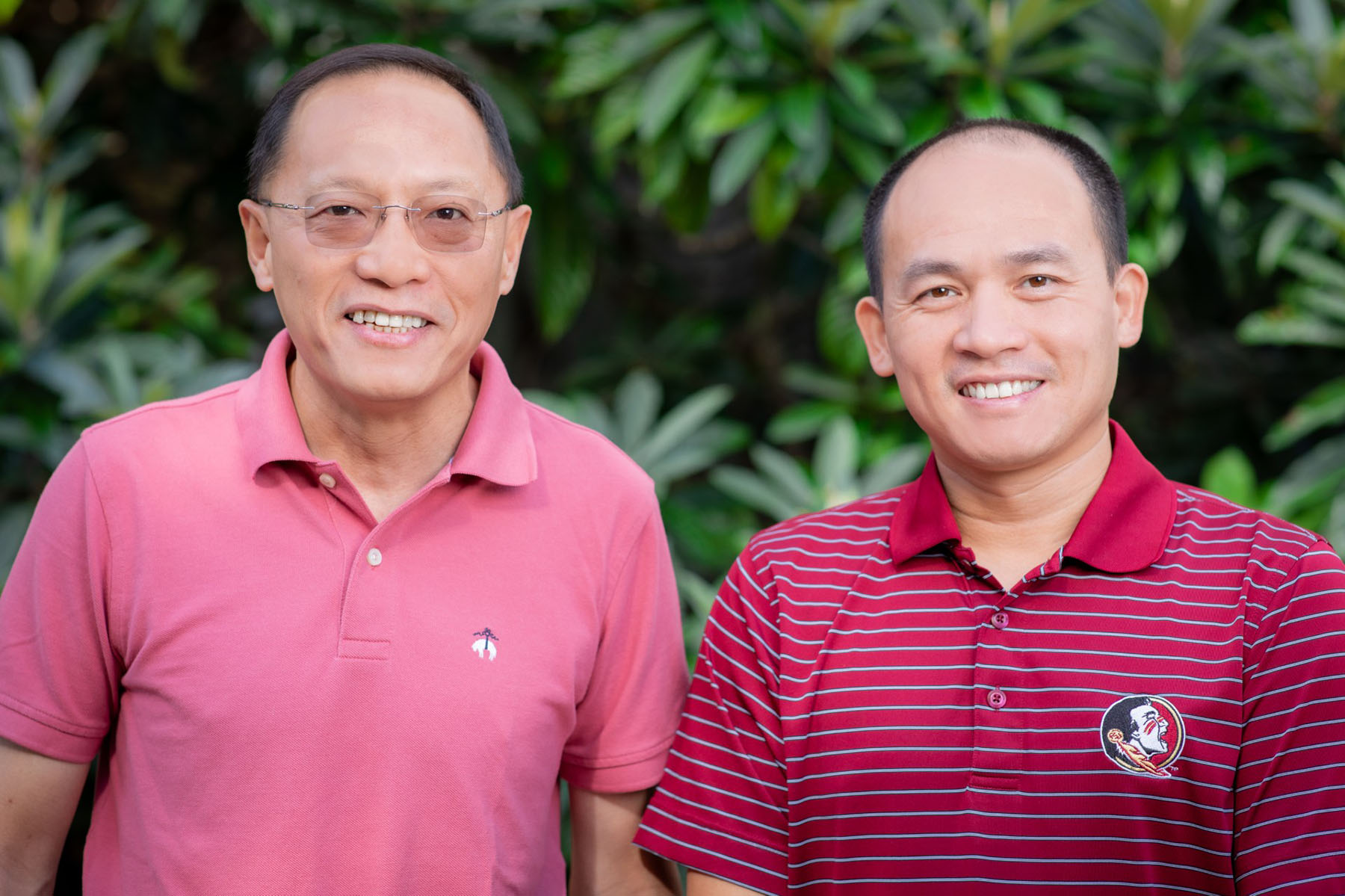
As phones and computers shrink in size, our need for data storage and transfer is growing. Electronic devices have been powered by semiconductors for decades, but as the push to miniaturize continues, there's a limit to how small semiconductors can be made.
The next generation of handheld devices requires a novel solution. Spintronics, or spin electronics, is a revolutionary new field in condensed-matter physics that can increase the memory and logic processing capability of nano-electronic devices while reducing power consumption and production costs. This is accomplished by using inexpensive materials and the magnetic properties of an electron's spin to perform memory and logic functions instead of using the flow of electron charge used in typical electronics. New work by Florida State University scientists is propelling spintronics research forward.
Professors Biwu Ma in the Department of Chemistry and Biochemistry and Peng Xiong in the Department of Physics work with low-dimensional organic metal halide hybrids, a new class of hybrid materials that can power optoelectronic devices like solar cells, light-emitting diodes, or LEDs and photodetectors. Together, they have identified new magnetic and electronic properties in these materials, pointing to impressive potential in spintronics. Xiong, in his solo work, has engineered the first instance of a magnet-free electron spin generation in a semiconductor, facilitating the low-cost development of high-powered electronic devices.
"While this new class of materials has proven useful in creating optical materials for optoelectronic devices, like LEDs, this is the first time we're observing some unique magnetic properties," said Ma, a renowned expert in materials chemistry. "Depending on the choices of appropriate organic and metal halide components, which theoretically could be unlimited, we are able to assemble them into crystalline structures with different dimensionalities. Different compositions and structures make them exhibit diverse properties, which can have a variety of applications, ranging from optoelectronics to spintronics, and even a combination of both."
Ma's lab synthesizes materials in varying configurations before sending them to Xiong's lab for electronic and magnetic characterizations - graduate students in both labs lead the experiments. Xiong's lab then gives feedback about the properties of the synthesized materials. In the article "Antiferromagnetic Ordering in A One-Dimensional Organic Copper Chloride Hybrid Insulator," published in Angewandte Chemie this summer, Ma and Xiong unveiled newly discovered properties, highlighting the potential of these materials as a highly tunable quantum platform for spintronics.
"It's exciting to think about how this is just one publication that was done on one specific material. We synthesize hundreds of materials, and we expect to see more interesting properties and useful applications emerge in the future."
- Biwu Ma, professor in the Department of Chemistry and Biochemistry
"It's exciting to think about how this is just one publication that was done on one specific material," Ma said. "We synthesize hundreds of materials, and we expect to see more interesting properties and useful applications emerge in the future."
This collaborative work was funded by the FSU Seed Program through the Council on Research and Creativity, the National Science Foundation, and the U. S. Department of Energy. Research teams led by FSU associate professor of chemistry and biochemistry Bin Ouyang and North Carolina State University associate professor of physics Dali Sun also contributed to this research.
"The collaboration between Biwu and myself is very natural," Xiong said of the ongoing four-year partnership. "There's a lot of back-and-forth in terms of feedback between material synthesis and property characterization in the two labs, what we have to fine-tune in synthesis to achieve optimal properties and more. It's highly interactive, and we have many different projects occurring at once with different materials."
While the duo's collaborative research focuses on developing new functional materials for use in spintronics, Xiong's individual research introduces an entirely new way of powering spintronics by exploiting the interaction of an electron's spin with chirality in its environment to produce magnet-free electron spin in a semiconductor.
Currently, spin generation is typically created through interaction with a magnet, and there are significant disadvantages with such schemes. For instance, fringe fields from external magnets can easily disrupt the spin alignment, leading to complications if multiple semiconductors are used in a small electronic device such as a high-density computer chip. In "Chirality-Induced Magnet-Free Spin Generation in a Semiconductor," published in Advanced Materials this summer, Xiong demonstrates a nonmagnetic pathway of spin generation.
"Instead of applying a voltage to the magnet to move the electron in and out of the semiconductor, we're flipping the spin of the electron in transit," Xiong said. "We found that when you force an electron to go through a chiral structure, which is a type of molecule that has a non-replicable mirror image, it becomes spin polarized and flips the electron to 'spin' in the way that aligns with the other electrons. Not only does this process utilize less energy than regular spin generation and lose less of it in the process, but it's also much easier to achieve high-density integration. Our next step is to achieve magnet-free spin generation using chiral semiconductors made in Biwu's lab instead of the very fragile chiral molecules."
This work was also presented as an invited talk at the 2024 American Physical Society March meeting. Additional contributors to this research include scientists from the Chinese Academy of Sciences, the Weizmann Institute of Science and the University of California Los Angeles.
To learn more about Ma's work and research in the Department of Chemistry and Biochemistry, visit chem.fsu.edu






